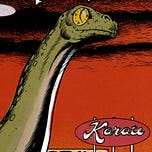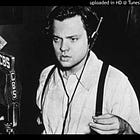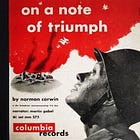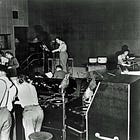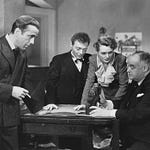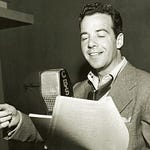Yesterday I posted the first of the Gerald Mohr episodes of The Adventures of Philip Marlowe. That’s the one that begins with the detective “getting tired of reading Philip Marlowe, Private Investigator backwards on the ground glass of my office door.” Firesign’s Nick Danger would take that line to its logical conclusion. Today I’m posting one more Philip Marlowe episode, one that contains many more of the hallmarks that can be heard on the “Nick Danger” side of How Can You Be in Two Places at Once When You’re Not Anywhere at All.
The most obvious of these is the way Chandler characterizes the private eye Marlowe, his hardboiled demeanor famously tempered with sentimentality (often to the detective’s detriment). When Firesign’s Nick Danger is (all too easily) coaxed by his ex-lover Nancy to meet her at the Old Same Place, it’s a scenario familiar from dozens of Philip Marlowe episodes including the one I’ve posted here (“The Pelican’s Roost”). This is rather different from the casual misogyny and off-the-rack machismo typical of Sam Spade, Johnny Dollar and many other radio detectives.
I think Firesign also noticed a particular story-telling trick that Philip Marlowe uses again and again in its broadcasts. Though it’s a convention of most radio procedurals for the radio detective both to tell each episode’s story and to act as a character within the story, there is usually a clear break that separates these two kinds of speech (and positions in the story). The storytelling of The Adventures of Philip Marlowe, by contrast, bleeds between Marlowe’s narration and his participation as a character, often within the space of a sentence. This happens several times in “The Pelican’s Roost.”
At 3:30:
MARLOWE: Well, it was 9:30 by the time that I got to Wilshire’s miracle mile that housed Eugene’s Beauty Shop. I drove by, saw no one outside, so I pulled into an alleyway, parked, and walked back slowly. As I passed in front of a show window I winked at a gilt mannequin with purple hair, and when I heard the door open behind me I stopped and lit a cigarette. Lynn Russell hurried by without a word, ran to a cab at the corner and drove away. And that was all there was to it. I turned around headed back to my own car and got as far as the handle on the door —oooff!! [thud] I fell against the car as the blow came again — ohhh! [whomp] — [gasping] it made … syrup of my legs. I oozed down on to the pavement and stayed there.
HOOD: I know you, you’re Marlowe, the private detective.
At 4:55:
MARLOWE: I pulled up in front of a wrought-iron arch labeled Garden Court Bungalows and followed a cool flagstone trail back to number four, which was Lynn’s. I felt almost normal again … until I saw her front door. It was standing half open framing a man in front of the dark interior who was trying his best to see inside. This time the advantage was mine AND I TOOK IT [wham!]!
SLOAN: Take your hands off me!
And 22:10 [note how this one also moves from past to present tense]
MARLOWE: The nickname for the cockeyed assortment of barnacle pilings that complain with every surge of the sea and then complained again with the undertow that followed was no misnomer. At least a thousand sleeping pelicans called it home. And now as I moved out across the splintered lopsided boards that here and there [CRACK!!] GAVE WAY, I, I try to be careful not to wake too many of the birds to flight because that would give me away.
There are many more amusing examples of this technique in other Philip Marlowe episodes, and if space permitted I would I want to think about it in relation to Marlowe’s hard-and-soft masculinity. For Firesign’s part, it was a trick they used repeatedly in “Nick Danger,” for both dramatic and comic effect, as with “And then it struck me [whomp!] … what a sap she had!” [13:10]”
One final thought: it is tempting to think that Firesign both heard this specific episode of June 25, 1950 and took note of the emergency CBS News bulletin that preceded it:
The Associated Press quotes an authoritative source in Tokyo as saying that some United States combat troops have been alerted to go into action in South Korea at a moment’s notice. According to this authoritative source, the deteriorating situation in southern Korea may force the United States to commit ground forces to the battle.
By the morning of the next day, the Korean War had begun.
As I’ve noticed in previous posts — and talk about in further detail in Firesign — 1969’s How Can You Be in Two Places at Once is the Firesign Theatre album that allegorizes most extensively the Vietnam, and its relation to communication technologies in general. It is reasonable to suggest that Firesign’s famous faux-FDR broadcast that comes at the end of “Nick Danger” (which I’ll discuss soon) may refer not only to the present crisis in Vietnam and to previous moment in radio history in which a radio detective paused to allow war to be declared.

